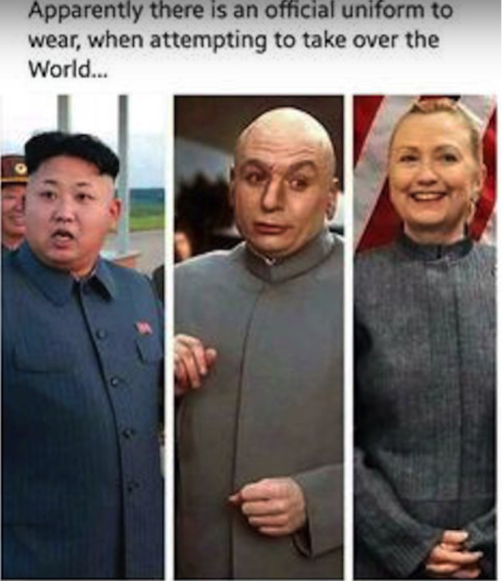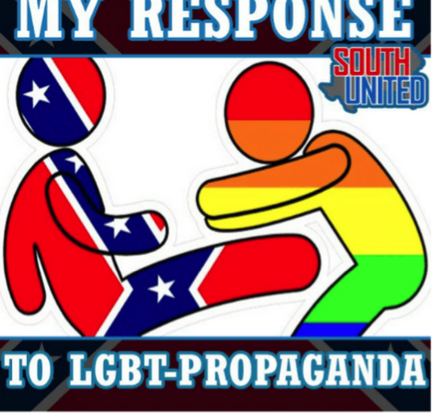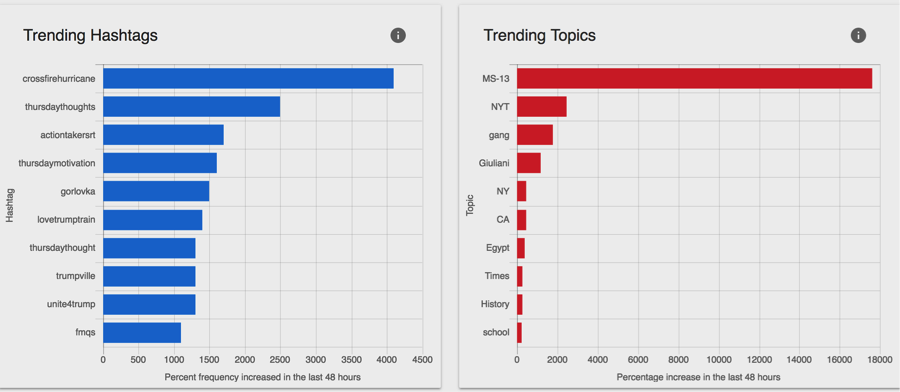What Did Russian Trolls Want in 2016? A Closer Look at the Internet Research Agency’s Active Measures

In March, after a more than yearlong investigation into Russian active measures used during the 2016 presidential campaign, the House Permanent Select Committee on Intelligence released its final report. The report asserted that the primary goal of Russia’s covert influence campaign through social media platforms was to “sow discord in American society” and to undermine citizens’ faith in the democratic process rather than to support a particular candidate. The committee also posited that while Russia actively supported “fringe political parties” and disparaged candidates seen as “hostile to Moscow” in Europe, this was not the case in the United States. Instead, the report summary asserted that the Russians had not favored Donald Trump over Hillary Clinton during the election, despite what the broader U.S. intelligence community had previously reported.
Trump publicly celebrated the House report, which seemed to legitimize his victory. But on May 15, the Senate Intelligence Committee finished its own investigation about Russian active measures, which starkly contradicted the House panel’s findings. The Senate committee asserted that Russia’s efforts to influence the U.S. election were “extensive, sophisticated, and ordered by President Putin himself,” and were done for the very “purpose of helping Donald Trump and hurting Hillary Clinton.”
What are we to make of the two committees arriving at opposing conclusions? To answer that question, this article re-examines Russian active measures to gauge whether the Russians were trying to assist Trump, as the Senate suggests, or simply attempting to undermine democracy and stir up discord without favoring any candidate, as the House states. Drawing from Russian and American reporting, congressional hearings, criminal indictments, and my research team’s own content analysis of Russian-backed social media content, this article demonstrates that, contrary to the House committee’s findings, the Russians did seek to explicitly promote Trump (and to a lesser extent Bernie Sanders) and to prevent, or at least delegitimize, a Clinton presidency. At the same time, the House report is still accurate in claiming that the Russians’ primary objective was – and still is – to stir up discord and distrust in American society, despite favoring Trump during the election. While the line between promoting such a controversial and, arguably, divisive candidate and generating broader social friction is certainly blurry, more knowledge of the motivations and strategies behind Russian active measures will help policymakers, industry leaders, and the public avoid susceptibility to these efforts, which are very much ongoing.
What Is the Internet Research Agency?
The best-known Russian “trolling farm,” as it is sometimes referred to, is the Internet Research Agency (IRA), a St. Petersburg-based entity first registered in 2013 and linked to a close Putin ally with ties to Russian intelligence. Early IRA employees were hired to write comments and blog posts, as well as to post videos, memes, and news stories under fictitious names that supported the current Russian government and criticized its opposition. In April 2014, the IRA then broadened its scope to develop, among others, a “translator project” to influence U.S. politics through social media platforms. The RBC, an independent Russian media outfit known for resisting censorship, notes that employees of the translator project, who began each day by turning on a proxy server to hide their location, received a daily list of opinions they were responsible for promulgating. Employees were also given “point-by-point exegeses of the themes they were to address, all pegged to the latest news,” although not much is known about who was responsible for assigning these tasks or setting the daily agenda.
Explicit Electoral Goals?
Accounts differ as to how IRA employees were directed to treat the U.S. presidential candidates. According to one former employee interviewed by the RBC, most of their tasks were not aimed at supporting a particular candidate, but rather at exploiting the divisiveness surrounding “acute social issues,” such as gun rights, immigration, and race relations. Exploiting these divisions frequently coincided with Trump’s rhetoric, but RBC’s sources note that these were viewed as moments of “correlation” rather than of “direct support.” “There was no task of ‘supporting Trump,’” one IRA employee insisted.
According to the Department of Justice, however, the trolls were indeed directed to support particular candidates. In his indictment of top IRA directors, Robert Mueller specifically argues that employees frequently posted derogatory information about Republican presidential hopefuls Marco Rubio and Ted Cruz, and by early 2016, had begun supporting both Trump and Sanders and disparaging Clinton on direct orders. For example, in February 2016, Mueller says IRA directors instructed their specialists to “use any opportunity to criticize Hillary and the rest (except Sanders and Trump — we support them).” Similarly, on Sept. 14, 2016, an internal review of the IRA’s anti-immigration Facebook account Secured Borders chastised its director for not deriding Clinton enough and was told to intensify the criticism in future posts.
To see how the account manager responded to this feedback, my team checked the posts by Secured Borders, which were made publicly available by Jonathan Albright at the website Data World after Facebook took down the account. On the day after the memo went out, three of the five pieces of content that Secured Borders posted directly mentioned or attacked Clinton by name. One asked, “How can anyone think that she is fit to be our president?” while another read “Americans before illegals! Trump knows it, Hillary thinks the opposite. The choice is yours.” The next day, the group also asked its followers to comment with seven words they thought best described Clinton, presumably to generate negative content directed at her. It’s hard to know what kind of uptick these posts represent since Albright’s log only starts tracking the posts on Sept. 12. But notably, none of the group’s sixteen posts in the three days prior to the internal memo mentioned Clinton at all.
My team also found other examples of influential Russian-backed accounts disparaging Clinton in a manner far more direct than simply fomenting discord. One notable instance came just after Sept. 11, 2016, when Clinton showed signs of weakness during a 9/11 memorial service and had to leave. According to her doctor, she was suffering from pneumonia and had become overheated and dehydrated. Russian-backed Twitter accounts, identified as such by NBC News and others, heavily exploited the incident to further the Trump campaign’s accusation that Clinton lacked the physical and mental stamina to be president. The popular Twitter account Ten_GOP posted 26 tweets on the topic on Sept. 11 and 12 alone. Accompanied by the hashtags #HillarysHealth and #ClintonCollapse, these tweets included sarcastic messages such as: “I agree w/ Hillary. The most important quality in a president is rock solid steadiness,” while others “demanded” Clinton’s medical records be made public and criticized “Selfish Hillary” for knowingly having pneumonia and appearing in public nonetheless.

Meme posted by the Russian-backed account Army of Jesus. (Source for all social media images: https://medium.com/@ushadrons)

Meme from Russian-backed account USA Gunslinger
In contrast, the Russian-backed Twittersphere was unsurprisingly quiet about Oct. 7, 2016, the day the Washington Post released a 2005 video of Trump bragging about his ability to do “anything” to women, including the now-infamous “grab them by the pussy.” The top Russian accounts ignored the story altogether, choosing to spend the day circulating accusations of Democratic voter fraud and spreading rumors about how counties in Florida were issuing curfews because “#Black Lives Matters thugs were refusing to evacuate” in advance of Hurricane Matthew. While these accounts were clearly tweeting to stir up cultural discord, their silence about the Trump tape also worked to promote his candidacy by seeking to limit the traction the story received on social media.
IRA trolls did not only operate by posting tweets and memes, however. They also posed as U.S. citizens and contacted real U.S.-based activists as part of efforts to promote their favored candidates. The RBC reports that IRA trolls managed to form a list of about 100 unsuspecting U.S. activists, who eventually helped with the organization of offline activities, including several political rallies in major cities. Some of these contacts unwittingly provided the IRA with valuable, broader insight into the U.S. political system. For instance, according to the Justice Department, in June 2016 the IRA made contact with an individual affiliated with a Texas-based grassroots organization, who advised the trolls to ignore Texas and focus their activities on “purple states like Colorado, Virginia & Florida.” “After that exchange,” Mueller’s indictment reads, “Defendants and their co-conspirators commonly referred to targeting ‘purple states’ in directing their efforts.”
The initial lack of awareness about “purple states” suggests that the trolls faced a steep learning curve as they tried to influence a complicated foreign political system from abroad. This learning curve may help explain some of the ineptitudes of early Russian Facebook ad spending. In a recent hearing, Senate Intelligence Committee Chairman Richard Burr highlighted some of the oddities of this spending. He argued that while the media has tried to spin a coherent story suggesting that Facebook ads were aimed with “laser-like precision” at an important subgroup of voters in Michigan and Wisconsin to help Trump win, the data paint a different story.
For example, Burr pointed out that the three states most heavily targeted by IRA-backed ads were Maryland, Missouri, and New York, and while the agency spent $300 on ads targeting the state of Pennsylvania, they spent five times as much in California. Likewise, almost five times as many ads were aimed at Maryland as at the important swing state of Wisconsin. Also, out of the 55 total ads aimed at Wisconsin, 35 ran prior to the Republican candidate having been decided, and not one of those ads mentioned Trump by name. If Burr’s data points are reflective of the complete ad spending campaign, it appears the Russian troll factory may have simply been purchasing ads in a somewhat random fashion, perhaps more concerned with sowing social and political unrest than with electing Trump. However, an alternate explanation may be that it wasn’t until the summer of 2016 that the IRA realized the importance of geographic targeting in the effort to turn the election in Trump’s favor.
And the data do suggest that, even if it lacked “laser-like precision,” the IRA did eventually turn its focus to swing states like Florida. For example, Mueller’s indictment reveals that in late July, the Russians began promoting a set of rallies through Twitter and Facebook that were collectively referred to as “Florida Goes Trump,” where, among other things, they paid one American to build a cage on a flatbed truck and another to wear a costume portraying Clinton in a prison uniform. My team’s scouring of popular Russian Twitter accounts also reveals that just one month before the election, Ten_GOP repeatedly attacked Clinton for buying political ad space on the Weather Channel during Hurricane Matthew, calling the move “sooo low.” Presumably they sought to suggest that Clinton might exploit Floridians’ attention to Matthew for political gain – a great irony considering that all of their tweets used the hashtag #Matthew for that exact purpose.
Finally, it is worth mentioning that in our search of 2016 Russian-backed memes, we struggled to find any content that supported Clinton or defamed Trump, further implying that the Russians were invested in a particular electoral outcome. The memes that circulated on Russian accounts looked much like those featured below, where either Trump or Sanders were celebrated and Clinton was defamed/belittled. This is telling because, as the next section illustrates, the Russians often posted material through different accounts that diametrically opposed each other in ideological content. It would stand to reason that some accounts, then, could have supported Clinton in order to generate conflict, but that was never the case. Each IRA post about Clinton worked to disparage her.

Post by Russian-backed account Army of Jesus.

Tweet by Russian–backed account Missouri News demonstrating support for Sanders.
A Broader Aim: Sowing Dissent and Doubts
It’s clear that the Senate was right to conclude that the Russians used social media to promote Trump (and to a lesser extent Sanders). But the House report is also correct that the overall active measures campaign was primarily focused on dividing the nation and eroding America’s faith in its democratic process. One must remember that up until election night, nearly every poll projected that Clinton would win the presidency by significant margins. Given this, the Russian trolls worked diligently to delegitimize a likely Clinton win so as to weaken her future leadership. For instance, throughout the course of the campaign, Russian trolls repeatedly posted content relating to voter fraud. According to the Justice Department, the Russian-backed account Stop A.I. ran an ad in August 2016 that claimed Clinton had committed voter fraud during the Iowa caucus. In the sample tweets released by NBC News, one can see that Ten_GOP also claimed that “tens of thousands of ineligible mail-in Hillary votes were being counted in Broward County, Florida,” while other accounts such as Emileewaren circulated a story on election day about voter fraud occurring in Pennsylvania, calling for Trump supporters to come out in the evening hours to “decide the election.” Such posts suggested that the election would be rigged in Clinton’s favor, so that in the event of her victory, she — and the whole democratic process — would be seen as corrupt and illegitimate.
USA Today’s content analysis of the 3500 Russian-sponsored ads recently released by the House Intelligence Committee also supports the notion that the IRA was primarily concerned with stirring up discord and distrust. According to their report, less than 3 percent of the ads released for review overtly mention either Trump or Clinton (but that when they do, they support the former and disparage the latter). In contrast, more than half of the ads dealt with divisive racial issues, with more than 25 percent centering on crime and policing, often with a racial connotation.
My team’s research further reveals that these cultural posts never promoted a unified ideology that the IRA hoped Americans would adopt. Instead, Russian trolls produced content that embraced a wide range of political thought, often in direct opposition to one another. (See the examples below). The goal of such posts, of course, is to divide Americans and keep them in a constant state of outrage — tactics that discourage unity and the rational, civil discourse essential to political compromise and action. If there’s any doubt that the trolls consciously espoused these motives, consider this post our team found from Secured Borders, published on Oct. 9, 2016:
BLM is a hate group sponsored by very rich and very white people like George Soros, who think they can manipulate people by pitting them up against each other. Soros and his government lobbyist friends know, When people are busy hating’ and fighting’ each other¨ they have no time to look around and see what is really going on. It’s a perfect way to prevent unity and understanding between people by clashing their differences deliberately. It’s a distraction for the real Americans — ‘whites’ and ‘blacks’ and ‘natives,’ whose ancestors lived here for centuries. While distracted many of them fail to notice how many invaders are already here and how much US Government supports these invaders.

Post from Nefertiti Community referencing Trayvon Martin and police brutality against unarmed black men and boys.

Post supportive of police officers from the group Back the Badge.

Post from South United promoting violence against the LGBTQ community

An inclusive post, supportive of the LGBTQ community, from Rainbow Nation.

Post from Merican Fury linking Islam with terrorism.

Post from Muslim Voice, criticizing racial and religious stereotypes.
These trends continue today. Hamilton 68, a project of the Alliance for Securing Democracy and the German Marshall Fund, tracks Twitter accounts linked to Russian influence campaigns. A review of the site on May 17, 2018, revealed that these accounts continue to support Trump, with three of their top ten trending hashtags including “loveTrumptrain,” “unite4Trump” and “Trumpville.” However, the other trending topics reflect the Russians’ efforts to continue to sow discord in U.S. society, especially by focusing on racial divides. The far most tweeted about topic on the day of my review was MS-13, which had come up the day before when Trump referred to undocumented immigrants and/or its gang members as “animals” — a classic example of how supporting Trump and his rhetoric also works to exacerbate cultural divides, further proving that the Russians remain committed to that goal, long after the election concluded.

A screenshot of the Hamilton 68 dashboard on May 17, 2018.
Conclusion
My team’s analysis supports the conclusion of many others, including the House panel, that Russian disinformation efforts extend far beyond efforts to influence elections. Many of these actions can only be explained in the context of a broader effort to fragment American society; indeed, the two goals perhaps cannot be separated. Of course, Russian efforts did not create these divisions, but rather, preyed upon them. It’s impossible to say how decisive these efforts were in affecting the outcome of the election or in creating today’s divided, polarized environment. It’s also impossible to know — right now — why Russia chooses to support Trump so explicitly. Perhaps promoting a divisive political figure — and disparaging another one — was simply an extension of its more intangible efforts to stoke anger, or perhaps the Kremlin had a more tangible interest in installing Trump as president. The U.S. intelligence community reported, for instance, that Vladimir Zhirinovskiy, leader of the nationalist Liberal Democratic Party of Russia, proclaimed that Trump won the election, “Russia would ‘drink champagne’ in anticipation of being able to advance its positions on Syria and Ukraine.”
While Facebook, Twitter and other platforms commit to reducing the amount of fake news and Russian trolls from their sites, it seems likely that Russian-backed social media content will continue to be a fact of life. Media literacy about these efforts will remain important. Even if officials can’t fully agree on what precise agendas the IRA is trying to carry out, greater awareness of the dangers posed by Russian active measures can help the public, tech companies, and Congress work to mitigate their damage, influence, and exposure. As such, I applaud moves like Congress’ recent decision to release the 3500 Russian-backed Facebook ads it had acquired. It also announced further plans to release over 80,000 pieces of the Russian accounts’ organically created content in the future. As the House Intelligence Committee minority writes, releasing and studying such ads is important: “sunlight is the best disinfectant against any future attempts to weaken our democracy or interfere in our free and fair elections process.”
Tricia Jenkins is a professor of film, television and digital media and the author of the CIA in Hollywood: How the Agency Shapes Film and Television, among numerous other articles that examine the links between government agencies and media content. She would like to acknowledge the work of Katie Kovarik and Addyson Jackson for their help with the research that appears in this piece.
Image: Amtec/Flickr

